These notes are intended to provide a casual sky watcher or someone already into amateur astronomy living in Eastern Australia with a summary of what is happening in the night sky in October 2012. The finder charts have been produced for an observer based in Brisbane (Queensland, Australia) but will be useful for observers elsewhere in Eastern Australia.
Instructions on how to obtain customised satellite viewing information for your location can be found here. If you find this page of interest, you may wish to follow this website automatically using Twitter and the sites RSS Feed.
Individual sky events (October 2012)
All times listed for the AEST time zone (U.T. plus 10 hours). Add one hour to times listed if your state or territory follows daylight savings time.
October 1: Mercury and the star Spica close above Western horizon in evening twilight.
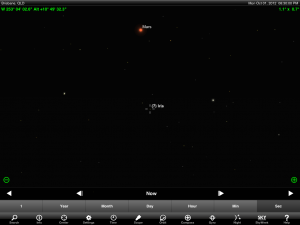
October 1: Mars 0.1 degree from minor planet 7 Iris
October 3: Venus and the star Regulus close. Morning twilight sky.
October 4: Jupiter stationary (Midnight)
October 4: Moon at apogee (furthest from Earth in its orbit at 405,160 km)
October 5: Gibbous Moon, the star Aldebaran and Jupiter make a temporary triangle in the morning sky
October 6: Mercury, Saturn and the star Spica make a temporary triangle low above the Western horizon in the early evening twilight. Difficult and will require a clear horizon.
October 6: Gibbous Moon and Jupiter close in the morning sky. Moon occults Jupiter from Southern Australia.
October 6: Moon furthest North (21.1 degrees)
October 8: Mercury at aphelion
October 8: Last Quarter Moon (5.33pm)
October 12: Waning thin crescent Moon, the star Regulus and Venus make a temporary triangle in the morning predawn sky low above the Eastern horizon
October 13: Waning thin crescent Moon locate to the right of Venus. Morning predawn sky low above the Eastern horizon
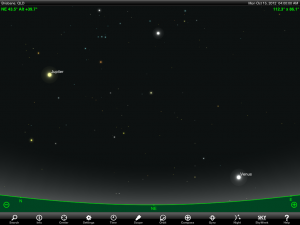
October 15: New Moon (10.03 pm)
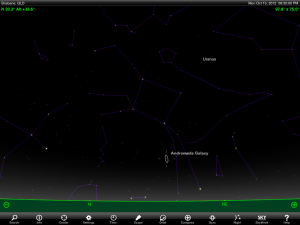
October 16: Slim crescent Moon located to left of and above Saturn. Low above the Western horizon in the evening twilight. Very difficult.
October 17: Moon at perigee (Closest to Earth in its orbit at 360,672 km)
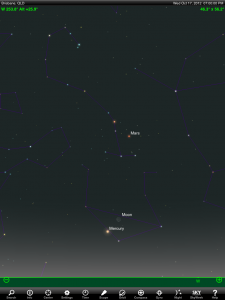
October 17: Moon located above and to the right of Mercury above Western horizon. Evening twilight and immediately afterwards.
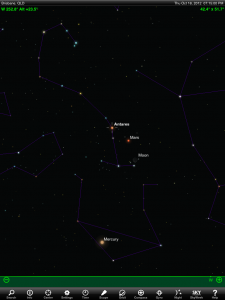
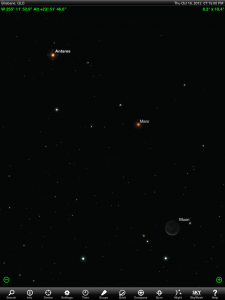
October 18: Crescent Moon located below Mars. Early evening sky.
October 19: Mars, the star Antares and the crescent Moon make a temporary triangle in the early evening sky
October 19: Moon furthest South (-21.1 degrees)
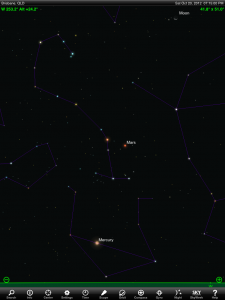
October 21: Mars and the star Antares 3.6 degrees apart
October 21: Minor planet Vesta stationary
October 22: First Quarter Moon (1.32 pm)
October 25: Saturn at conjunction 7pm
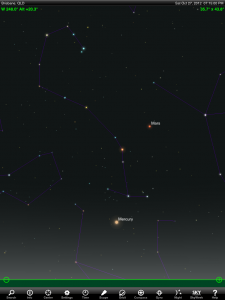
October 27: Mercury greatest elongation East (24 degrees from Sun) (1am)
October 28: Mercury at greatest latitude South
October 30: Full Moon (5.49 am)
October 31: Minor planet Ceres stationary
October 31: Venus at perihelion
For Further Information
Planet and Moon Rise/Set Times
Planet and Moon rise/set times for 2012 can be found here on this website.
Customised Astronomy & Satellite Viewing information
Information on how to obtain customised astronomy & satellite viewing information for your location can be found here on this website.
References
The information in this post has been prepared using the following references.
Occult 4 astronomy software by David Herald, http://www.lunar-occultations.
Astronomy 2012, Quasar Publishing http://www.quasarastronomy.
Sky Safari Pro Ipad app, http://www.southernstars.com/
Stellarium astronomy software http://www.stellarium.org/